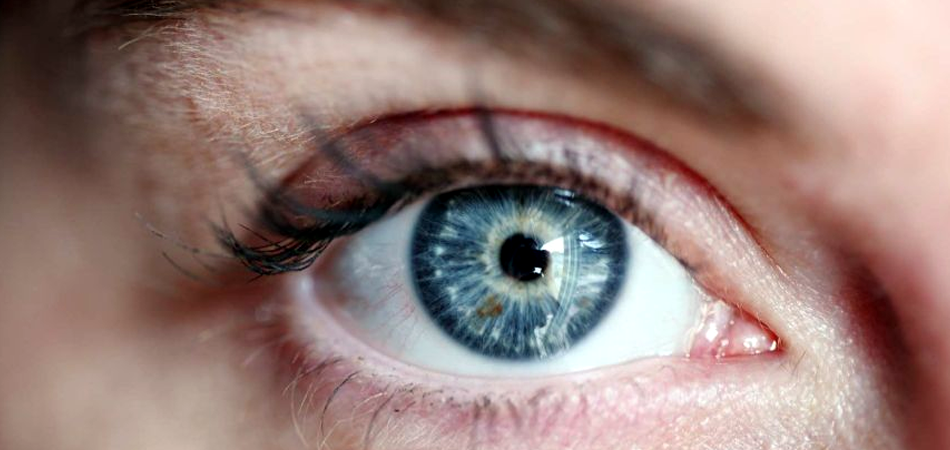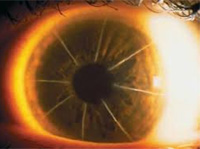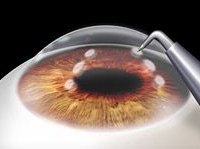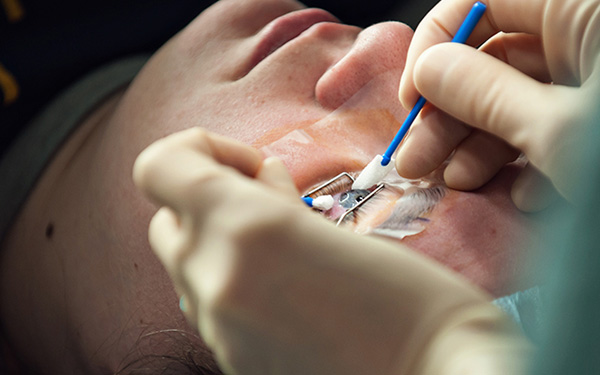Delhi | Kolkata
Bangalore | Chennai
Eye Surgery in India

The health of our eyes is vital to overall happiness and welfare. When we consider that over 80% of what we take in from the world is through what we see through our eyes, the significance of their health cannot be ignored. Our eyes can capture and understand more than one-million pulse signals per millisecond and link them to the brain. Your eyes are truly incredible organs. Your eyes, like other organs of your body, are prone to stress and injury and can lose their full potential if not properly taken care of. It’s important to conserve the health of your eyes even as you grow older. Healthy eyes are a critical constituent in learning and experiencing growth and development.
Leading a healthy lifestyle of exercise and proper nourishment can help keep your eyes functioning properly well into your later years. Most people don’t start thinking about eye health until they feel that there is some change in their eyesight. Our eyes are like all other organs in your body, in that they change as we grow older. Keeping them healthy when you are in your 20’s and 30’s will prepare you well for when the alteration of your eyes begins.
Eye Surgery
Eye surgery, also known as ocular surgery, is surgery accomplished on the eye or its adnexa, usually by an ophthalmologist. The eye is a very delicate organ, and requires extreme care before, during, and after a surgical procedure to minimise or inhibit further damage. An expert eye surgeon is accountable for selecting the suitable surgical procedure for the patient, and for taking the necessary safety precautions. Evidences of eye surgery can be found in several ancient texts dating back as early as 1800 BC, with cataract treatment beginning in the fifth century BC. Today it remains an extensively practiced kind of surgery, having recognized various techniques for treating eye problems.

Until contact lenses were propagated in the 1950s, eyeglasses for at least the past seven centuries had been the only practical way to correct refractive vision problems.
Now, numerous contemporary approaches to corrective eye surgery range from laser reshaping of the eye's surface in techniques such as LASIK and PRK to surgical attachment of artificial lenses to correct eyesight.
In LASIK, PRK, and associated techniques, laser energy modifies the curvature of the eye's clear front surface (cornea) to change the way light rays enter through the eye. Artificial lenses surgically inserted into the eye also can refocus light rays to improve vision.
Precautions and Preparations
Since the eye is mostly supplied by nerves, anaesthesia is vital. Local anaesthesia is most frequently used. Topical anaesthesia using lidocaine topical gel is frequently used for quick techniques. Since topical anaesthesia requires collaboration from the patient, common anaesthesia is often used for children, painful eye injuries, or major orbitotomies, and for hesitant patients. The physician overseeing administration of anaesthesia, or a nurse anaesthetist or anaesthetist assistant with expertise in anaesthesia of the eye, observes the patient's cardiovascular condition. Sterile safeguards are taken to prepare the part for surgery and minimize the risk of infection. These precautions comprise the use of antiseptics, such as povidone-iodine, and disinfected drapes, gowns, and gloves.
The Evolution of Corrective Eye Surgery and its Types
Over the past 25 years, surgical techniques, tools, and techniques for vision correction have progressed rapidly.
1.) Radial Keratotomy (RK)  , used in the United States, chiefly during the 1980s, involved cutting spoke-like cuts to flatten the eye's surface primarily to correct near-sightedness.
, used in the United States, chiefly during the 1980s, involved cutting spoke-like cuts to flatten the eye's surface primarily to correct near-sightedness.
But outcomes, especially long-standing, created difficulties for some persons. Significant glare, deterioration, inconsistent vision, and other side effects such as night vision problems were general in patients who had Radial Keratotomy for greater prescription strengths, while such side effects were less common in patients with lesser prescriptions.
Radial Keratotomy is now almost obsolete as a primary vision correction practice for these reasons and because of developments in laser vision correction procedures.
2.) Photorefractive Keratectomy (PRK)  was the initial effective laser vision correction method used to eliminate (ablate) tissue straight from the eye's surface to modify the curvature of the cornea. PRK, also known as surface ablation, was executed outside the United States during the 1980s and received FDA authorization in 1995. PRK is still frequently used, but LASIK is by far the most prevalent laser procedure today.
was the initial effective laser vision correction method used to eliminate (ablate) tissue straight from the eye's surface to modify the curvature of the cornea. PRK, also known as surface ablation, was executed outside the United States during the 1980s and received FDA authorization in 1995. PRK is still frequently used, but LASIK is by far the most prevalent laser procedure today.
3.) LASIK (laser-assisted in situ keratomileusis)  comprises creating an ultra-thin hinged flap in the thin outer covering (epithelium) of the eye and floating it away from the eye's surface with alcohol so that laser reshaping of the eye can take place.
comprises creating an ultra-thin hinged flap in the thin outer covering (epithelium) of the eye and floating it away from the eye's surface with alcohol so that laser reshaping of the eye can take place.
• Epi-LASIK is like LASIK, bar that a special cutting tool is employed to lift the flap.
• Bladeless LASIK removes the requisite to use a bladed instrument (microkeratome) in LASIK surgery. In its place, a femtosecond laser is used to create the corneal flap prior to restructuring the cornea with an excimer laser. Other names (including brand names) for bladeless LASIK include blade-free LASIK, all-laser LASIK, femto LASIK, Intralase LASIK, intraLASIK, iLASIK, VisuMax and zLASIK.
• Wavefront LASIK or PRK (also known as wavefront-guided, wavefront-assisted, or custom LASIK/PRK) integrates ultra-modern study, known as wavefront, to calculate precisely how light travels through the eye. Excimer lasers with built-in wavefront analysis can identify and spontaneously adjust for subtle vision errors when laser energy is applied to reshape the cornea. Studies suggest wavefront-guided LASIK helps retain contrast sensitivity and decreases the risk of night glare after LASIK surgery.
However, PRK has made a comeback in recent years because of studies showing that PRK and LASIK produce similar results. Also, nerve regeneration in the eye's surface seems to take place more rapidly with PRK than with LASIK following a procedure, which could have effects for reducing dry eye and other difficulties that might ensue until the healing process is finished.
Because PRK is a surface technique, there also is no risk of surgical flap difficulties. PRK does not comprise creating a thin, hinged flap on the eye's surface, as occurs with LASIK. PRK also appears to be a safer method in cases when a person's cornea may be too thin for LASIK operation.
Current scientific advances have given eye surgeons better approaches of creating thinner flaps in a foreseeable way, meaning that people with thin corneas now might be candidates for a LASIK procedure.
However, you may consider a separate kind of vision correction procedure if you have a thin cornea and advanced degree of myopia that would require additional ablation to reshape the eye.
LASIK's main advantage over PRK is that there is little or no discomfort immediately after the procedure, and vision is usually clear within hours rather than days. Different forms of LASIK exist, many that depend on how the flap is created.
Conductive Keratoplasty (NearVision CK by Refractec) uses a tiny probe and low heat radio waves to apply "spots" around the margins of the eye's clear front surface. This fairly non-invasive method steepens the cornea, to deliver near vision correction for people who are farsighted. CK also can be used to correct presbyopia or improve near vision for people who have had LASIK or cataract surgery. CK received initial FDA approval in 2002.
(NearVision CK by Refractec) uses a tiny probe and low heat radio waves to apply "spots" around the margins of the eye's clear front surface. This fairly non-invasive method steepens the cornea, to deliver near vision correction for people who are farsighted. CK also can be used to correct presbyopia or improve near vision for people who have had LASIK or cataract surgery. CK received initial FDA approval in 2002.
Implantable Lenses (Visian ICL and Verisyse), related to contact lenses, first received FDA approval in 2004. These surgically embedded lenses primarily are considered suitable for higher degrees of nearsightedness. When implantable lenses are used, your eye's natural lens is kept in place. Both of these lenses have an extensive track record of use, including more than 15 years in Europe.
related to contact lenses, first received FDA approval in 2004. These surgically embedded lenses primarily are considered suitable for higher degrees of nearsightedness. When implantable lenses are used, your eye's natural lens is kept in place. Both of these lenses have an extensive track record of use, including more than 15 years in Europe.
Refractive Lens Exchange is one more non-laser, internal eye procedure. RLE is much like cataract surgery. But as an alternative of getting rid of the eye's natural lens that has grown hazy due to cataract formation, RLE involves removing a clear natural lens and substituting it with an artificial lens of a unalike shape, usually to decrease or remove high degrees of farsightedness.
is one more non-laser, internal eye procedure. RLE is much like cataract surgery. But as an alternative of getting rid of the eye's natural lens that has grown hazy due to cataract formation, RLE involves removing a clear natural lens and substituting it with an artificial lens of a unalike shape, usually to decrease or remove high degrees of farsightedness.
RLE also might be considered as an option for amending other types of vision problems, such as near sightedness. But RLE has a greater risk of difficulties, in comparison to other vision correction procedures. For these reasons, RLE normally is used only in cases of stark vision correction needs.
Cataract surgery also can now be thought of as a vision correction process. New lens implants developed for cataract surgery can partly repair a person's near vision in addition to fixing near sightedness and farsightedness. These lenses, called multifocal IOLs or accommodating IOLs, presently are being used by many cataract surgeons, with favourable outcomes.
also can now be thought of as a vision correction process. New lens implants developed for cataract surgery can partly repair a person's near vision in addition to fixing near sightedness and farsightedness. These lenses, called multifocal IOLs or accommodating IOLs, presently are being used by many cataract surgeons, with favourable outcomes.
Also, toric IOLs that correct astigmatism can be used in cataract surgery to decrease the prerequisite for eyeglasses after cataracts are removed.
While Medicare and health insurance will cover elementary costs of cataract surgery, you can choose to pay out-of-pocket for the extra costs of these more contemporary lenses that possibly can restore a full range of vision. This is why cataract surgery at present also can be regarded as a refractive surgery procedure, but only when you opt to pay additional for full vision adjustment.
Which Corrective Eye Surgery Procedure Is Right for You?
Since our eyes change as we age, the type of laser eye surgery or other vision modification we need also may change. Certain methods to LASIK or other processes that work well for younger adults, for example, may be unsuitable for older individuals.
In some situations, vision correction surgery may be ruled out totally. Children under age 18 rarely would be taken into account as candidates for laser vision correction because their eyes change too quickly as their bodies grow and mature.
Also, some people have peculiar conditions or diseases that would make them poor nominees for certain vision correction procedures and better candidates for other techniques. Examples:
• If one has diabetes or other diseases that affect wound recovery, one might be a better candidate for PRK or LASEK than certain kinds of LASIK.
• If one has uncontrolled glaucoma, one likely would not be suitable for LASIK or certain other procedures.
Keep in mind that, usually, anyone who is pregnant should not undergo any sort of elective vision surgery, because hormonal variations might affect the treatment's precision.
Lifestyle also can be a big factor in the type of vision correction one might need. A seamstress needs keen near vision. Computer users need good vision at intermediary ranges. And a pilot needs to reserve depth perception to make good spatially oriented decisions while flying.
Normally speaking, however, people in their 20s or 30s with slight to moderate farsightedness, nearsightedness, and/or astigmatism are usually outstanding candidates for LASIK, PRK, Visian ICL, and other laser vision correction.
Severe Vision Errors and Corrective Eye Surgery for Older People

If you are 40 or older or have severe vision problems, you may want to confer these options with your eye surgeon:
• Monovision: With this method, LASIK may be used to correct one eye for distance vision and the other eye for near vision as a solution for presbyopia, a focusing problem that affects all people starting at around age 40.
However, some people cannot adjust to monovision. One might first contemplate wearing contact lenses providing monovision or trying it with "trial lenses" in their doctor's office, to make sure this method works for you.
Conductive Keratoplasty also delivers a type of mono vision, but with a more full range of vision in the corrected eye.
• Multifocal or Accommodating IOLs: If one chooses this kind of lens for a refractive lens substitution or cataract surgery, the eye's natural lens will be exchanged permanently. These artificial lenses potentially can restore a full range of vision, but can also produce side effects such as decreased depth perception or night vision problems in the form of halos or glare. Also, you may still need to wear eyeglasses or contact lenses or have a "laser touch-up," because it's possible the lenses will fall short of re-establishing a full range of vision. Be sure and discuss the pros and cons of these new lenses with the eye surgeon.
• Vision Correction for Severe Near sightedness or Farsightedness. LASIK, PRK and other laser vision correction procedures do have their restrictions and may not be the best option if one has stark near sightedness or farsightedness. Some eye surgeons consider implantable lenses (Visian ICL and Verisyse) the best option for extreme near sightedness.
Refractive lens exchange, in which the eye's natural lens is swapped with an artificial one, is a likely option for extreme farsightedness.
Mainly, if you are older than 40, you also might need to consider multiple vision correction solutions to attain the very best permitted vision for your age and lifestyle.
For instance, you might choose LASIK or PRK in your 30s to correct distance vision. Then, when you reach your mid-40s and your near vision is affected by presbyopia, you might follow up with an "enhancement" using conductive keratoplasty.
With CK in one eye, you may be able to improve near vision blurriness caused by the age-related ailment of presbyopia.
Conclusion
Most eye surgeons will tell you it's unlikely that any vision correction procedure can give you enduring, optimal vision for a lifetime. Just as it was compulsory to change out eyeglasses and contact lenses in the past, you very likely will need a LASIK enhancement or other surgical correction as you grow older, to preserve good vision.
Also, keep in attention that all vision correction processes have the usually slight risk of side effects that can range from mild to severe. So one has to be sure to discuss all options and potential risks in detail with their eye surgeon or eye care provider in advance before making any absolute choices.
* Conditions Apply

